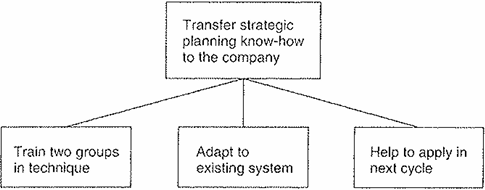Distinguish the Levels of Action
Most people's tendency in laying out a set of steps is to list them all in the order in which they intend you to take them. But in doing so they generally combine causes and effects at the same level.
Accordingly, another technique you want to adopt is deliberately to distinguish the levels of action as you find them, so that you can limit the number of steps at any level to five or fewer. This Makes it much easier to see the overall structure of a process, and also means you have fewer ideas for which to find the summary effect.
Distinguishing levels of action is relatively simple: an idea is at the same level if you expect the reader to take this action before he takes the next action listed; it is at a lower level if you expect him to take it so that he can produce the next action. Thus:
A firm that wants to be on top of its telecommunications problems might benefit from the following program.
1. Analyze present facilities and usage
2. Identify the main business tasks needing more (or less) support
3. Set objectives for telecommunications
4. Provide researchers for review
5. Examine relationships with telecommunications suppliers
6. Identify main technological options
7. Control internal telecommunications costs
8. Scrutinize equipment policies
9. Examine existing communications links
10. Determine your organizational approach
It is tempting to leave this list as it is, given that all of the steps need to be taken if a company is to have a properly supportive telecommunications system. But if you sort out what is being done before from what is being done so that you get a list like this:
1. Set your telecommunications objectives (3)
- Analyze present facilities and usage (1)
- Identify the main business tasks needing support (2)
- Examine existing communications links (9)
2. Set up a project team to choose the proper equipment (4)
- Identify the main technological options (6)
- Scrutinize equipment policies (8)
- Examine relationships with telecommunications suppliers (5)
3. Create a framework for organizational control (10)
-Appoint a central manager (?)
- Establish a cost control system (7)
Now not only can you quickly grasp what the program involves, you can also make objective judgments about whether you have left any points out. For example, how does one identify the main business tasks needing support? Or create a framework for organizational control? And perhaps they need a central manager.
While you want to be sure to distinguish levels of action, you don't want to overdo the technique, which can easily happen-again because people have such a tendency to classify. There is a great love, especially among consulting firms, of specifically distinguishing Tasks vs Objectives vs Benefits of a project, like this:

This classifying of sets of actions assum.es that there is a clear fence between the steps labeled Tasks and those labeled Objectives and Benefits, and that first you achieve the Tasks, then you achieve the Objectives, then you achieve the Benefits. That is indeed what you do do, but the hierarchy thus implied is this one.

As you can see, we are now slicing the pyramid horizontally instead of vertically, because accomplishing the Tasks leads to achievement of the Objectives, and accomplishing the Objectives leads to achievement of the Benefits. But the effect on clarifying the thinking is no better. We are now implying that labeling the levels of abstraction will allow us to identify the kind of action that goes at each level. In other words, we should be able to tell by looking at it whether any specific action is an Objective or a Benefit or a Task.
But that of course is nonsense. We already know that action ideas cannot be classified; they can only legitimately be united by their ability to bring about a specific effect. Classifying action ideas will inevitably lead to repetition, since there is nothing intrinsic to distinguish a Task from an Objective from a Benefit. The only legitimate way to organize is around end-product actions.
To demonstrate, here is an instance of labeling actions that was used by a consulting firm hired to train a client's people to do strategic planning. In abbreviated form, the firm had agreed to perform six tasks, which required them to set five objectives, achieving which they presumed would produce three benefits.

A good technique for sorting out a set of ideas like this is to pare them to their barest essence, and then find the repetitions. If we apply the technique to this grouping, what do we get?

Now both the repetitions and levels of abstraction are relatively easy to see, leading to a pyramid structured around end-product actions.

And with a little work you would end up saying this:
We will rapidly transfer strategic planning know-how to your company (2, 7, 13)
1. Train two product advisory groups in the techniques and concepts of strategic planning (l, 12)
2. Adapt these concepts to your existing planning system (4, 5, 8, 9)
3. Work with your people to apply the concepts during the next planning cycle (3, 6, 10, 11, 14)
You have now organized the thinking around end-product actions, not around categories of ideas.
 الاكثر قراءة في Writing
الاكثر قراءة في Writing
 اخر الاخبار
اخر الاخبار
اخبار العتبة العباسية المقدسة


